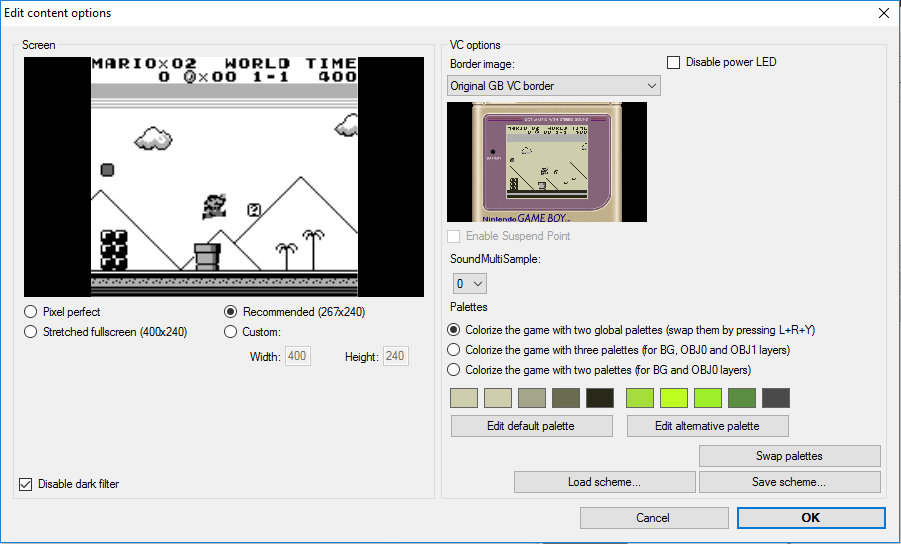


We’ve seen some very unique custom keycaps recently, but nothing quite like the embroidered ones that has been experimenting with. They’re available for a song as decommissioned store shelf price tags now, and they might be nice since the icon would persist without power.Ĭontinue reading “Adaptive Macro-Pad Uses Tiny OLED Screens As Keycaps” → Posted in Peripherals Hacks Tagged adaptive, hid, icons, input, keyboard, keycap, keypad, macro, oled We love the look and the functionality has built into Keybon, but we wonder if e-ink displays would be a good choice for the keycaps too. The app supports up to eight macro sets and can be seen in action in the video below. This gives the users access to custom macros for a web browser, EDA suite, CAD applications, or an IDE.
#GAME BOY COLORIZER TOOL WINDOWS#
But when used with its companion Windows application, the entire macro set can be switched out to accommodate whatever application is being used. By itself, it boots up with a standard set of icons and sends the corresponding keystrokes over USB. The other trick that Keybon has is interactivity. He had to deal with the problem of the keycaps just wobbling around atop the switch button without depressing it this was solved with a 3D-printed cantilever frame that forced the keycaps to pivot only in one axis, resulting in clean, satisfyingly clicky keypresses. Each of the nine 0.66″ displays has a resolution of 64 x 48 pixels, which is plenty for all kinds of icons, and each is mounted over an SMD pushbutton switch.

But looks can be deceiving, and worked a couple of surprises into Keybon.įirst of all, each one of Keybon’s buttons is actually a tiny OLED display, making the keycaps customizable through software. It honestly looked like any other USB macro keyboard, with big icons for various common tasks on the chunky keys. When we first laid eyes on Keybon, the adaptive macro keyboard, we sort of wondered what the big deal was. If you’re executing your own retro repairs, be sure to drop us a line! Posted in Misc Hacks Tagged keycap, keycaps, vacuum forming We’ve seen ’s work in this space before, too, like this extreme modded Amiga.
#GAME BOY COLORIZER TOOL HOW TO#
If you’ve got the inside knowledge on how to make this work, sound off in the comments. We can imagine this technique being an accessible way to colorize keycaps for a vintage cyberdeck or chiptune rig, without permanently modifying the keys. isn’t giving up however, and plans to build a new vacuum table with greater performance. The final product showed many wrinkles and was distinctly unappealing. Uneven heating of the plastic film and a lack of rigidity in the carriage used to stretch it over the keycaps led to poor results. However, scaling up the process proved fraught. Initial small-scale tests were promising, creating a key with a tight, form-fitting blue plastic wrap through which the original labels were still visible. The basic idea was to use a vacuum-forming machine to coat keycaps in a thin layer of translucent plastic, for both aesthetic benefit and to preserve them from falling apart. has long experimented with techniques to preserve and refresh keycaps, and decided to try some fun vacuum forming techniques for something new. Plastic is an awful material when it comes to decade-long timescales, and the forces of sun, air and water are unrelenting on these materials. Retrocomputing is as much about physical preservation as it is about electronics and computer science. Posted in Misc Hacks Tagged 3D printed keycaps, clay, keycap, keycaps, sla printing Still not tactile or custom enough for you? These hand-stitched keycaps are technically re-legendable, though it would take a considerable amount of time. You could go nuts with colored clay and make a retro-RGB clackable rainbow. Of course, as mentions, you’re not restricted to white or even air-dry clay. And he had better luck thick fonts like Arial Black instead of thin fonts. soon figured out that the grooves had to be pretty deep for this to work right - at least 1 mm. After printing, they are sprayed with acrylic, and then works a generous amount of clay into the grooves and seals the whole thing with clear spray. These babies are printed in black resin and the inlay is made with white air-dry clay. When couldn’t find any resources about re-creating the groovy ‘caps of thocky old keebs like the Space Cadet and the C64 (or find any to buy), it was time for a little keycap experimentation. They say experience is the best teacher, and experience tells us they are right.


 0 kommentar(er)
0 kommentar(er)
